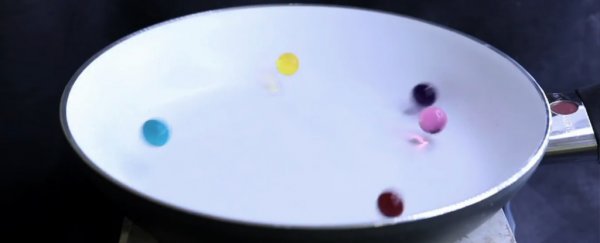It all started when a Ukrainian programmer and aspiring rapper dropped a handful of hydrogel balls on his piping-hot pancake griddle.
The beads, used by gardeners to hydrate plants because they're about 98 percent water, began to bounce. The man recorded their jig of little hops for several minutes, complete with the horrible screeching sounds the spheres emitted.
More than a million people have viewed it on YouTube since late 2015.
The clip caught the eye of Scott Waitukaitis, an expert in the physics of soft materials at Leiden University in the Netherlands. He saw the bouncing balls (below) while scrolling on his cellphone at a scientific conference.
"They come to life, essentially, and scream," he said.
His delight gave way to curiosity, and he decided to replicate the viral video in the lab, using high-speed cameras to figure out why the balls could bounce for so long.
Waitukaitis and his colleagues focused on what happens when a hydrogel connects with the very hot surface. Immediately, the contact results in a burst of steam. This forces the bottom of the ball to vibrate, as the researchers reported in the journal Nature Physics on Monday.
"That vapour builds up pressure that actually deforms the bottom of the ball," Waitukaitis said.
The gels, infused with fresh spurts of energy, kept on bouncing — on the order of 1,000 bounces at a go. (These oscillations also turned the balls into high-pitched shriekers.)
It was a new aspect of a curious natural phenomenon.
"We found a fundamentally new type of Leidenfrost effect," Waitukaitis said.
In the classic example of the Leidenfrost effect, a liquid floats on the surface of an object heated far above the liquid's boiling point. It's why water droplets skitter around a very hot griddle. The bottom of the droplet turns to vapor, a buffer between the hovering droplet and the heat.
"The water can actually float around the top of the frying pan," Waitukaitis said.
For the hydrogels, the Leidenfrost effect turned each ball into a tiny steam engine. The ball was like fuel, cylinder and piston wrapped into one, the physicist said.
Even the bounciest rubber ball will come to rest, because with every descent it loses energy on contact with the ground. The hydrogel balls lose energy, too. But they gain it back from the vapour bursts.
The spheres bounced for up to 10 minutes, Waitukaitis said, stopping only when the tiny bit of polymer holding the ball together starts to melt and the ball itself cracks open.
Waitukaitis envisions applying this phenomenon to the field of soft robotics. Energy sources are something of a puzzle for soft robots; most robots are either tethered or have to rely on rigid circuits and batteries.
But, based on this research, Waitukaitis said that hot wires threaded through hydrogel-like materials might avoid the need for hard components.
"We want to make soft engines that are more efficient and smarter," he said. And the Leidenfrost effect just might do the trick.
2017 © The Washington Post
This article was originally published by The Washington Post.
